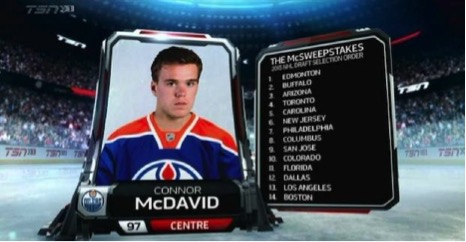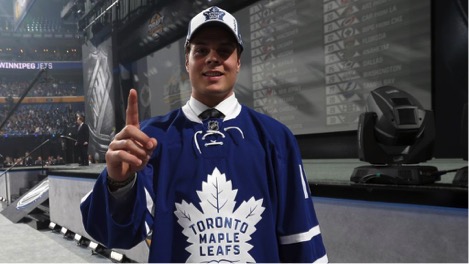
Ever since the term “generational talent/player” was coined roughly a decade in the 2005 National Hockey League (NHL) Draft, a highly-anticipated draft that produced the current fact of the NHL in Crosby, NHL General Managers (GMs)—especially those whose teams are at or near the very bottom of the NHL standings from the previous season—have been actively chasing the next such phenom. While these GMs in all likelihood have the luxury of high draft choices—assuming that these GMs (or their predecessors) have not traded their first round selection away—the task of landing the next “generational talent” remains elusive at times because so many things have to break right for it to happen rather than just merely wishful thinking.
By all accounts, there are two prerequisites that need to be met for a team to secure a “generational player.” First, the draft has to be one that features such a phenom. Until Connor McDavid came along in 2015, Edmonton did not get their “generational talent” despite having three consecutive first overall picks of the NHL Entry Draft from 2010 to 2012, in part because none of Taylor Hall (who is an elite player), Ryan Nugent-Hopkins (who is a good to arguably very good player), and Nail Yakupov (who has been a bust to this date) are true “generational players” from a talent perspective. Second, even if such a “generational talent” is available in the draft, a team would need to hold the first overall selection in order to guarantee itself of having the opportunity to choose the phenom seeing that it is extremely unlikely that other teams would pass on him. Further complicating the matter, the team that finishes in last (thirtieth) place is no longer automatically granted the top (first overall) pick in the upcoming NHL Entry Draft as the league has put into place a draft lottery system since the “Sidney Crosby sweepstakes” in 2005 as a way to stop teams from intentionally losing games to secure the top selection of the upcoming NHL Entry Draft. In fact, the NHL further tightened its grip in the most recent (2016) NHL Entry Draft in order to deter teams from “tanking.” Whereas the team that finished in last place had a twenty-five percent chance of winning the draft lottery and retaining the top pick in the NHL Entry Draft from 2006 to 2015, the team that finishes in thirtieth place now (2016 and onwards) only has a twenty percent chance of winning the draft lottery and keeping the first overall selection (not to mention that it could drop to the third or fourth overall pick given that the top three selections are determined by separate lottery draws). Just ask poor Buffalo, as the Sabres, who had to settle picking second overall having lost the draft lottery in back-to-back years after finishing in the basement for both the 2014 and 2015 seasons. Instead of getting Aaron Ekblad in the 2014 NHL Entry Draft, Buffalo had to go with Sam Reinhart. Instead of welcoming McDavid to the city of Buffalo, the Sabres had to take Jack Eichel, even though Buffalo GM Tim Murray insisted that Eichel is every bit the “generational player” that McDavid is because unlike the overwhelming majority of previous drafts, the 2015 NHL Entry Draft had the unusual spectacle of having not one but TWO “generational talents” in McDavid and Eichel for the taking! Curious considering that Murray could not hide his disappointment at the 2015 Draft Lottery after losing out on the Connor McDavid sweepstakes to Edmonton when he minted words such as “I’m disappointed for our fans” as well as statements such as, “Thankfully it’s a short drive from Buffalo. I’d hate like hell to be flying across the country to take part in it”; “When you have an eighty percent of losing something, you have to be ready for that and think that’s probably going to be the case and that was the case;” and three, “This is two years of me coming up here. It’s a two-minute draw, I guess. One team is happy, and the rest aren’t.”

Is the story always bleak for the team that finished dead last in the league heading into the draft lottery with reduced odds in their favour? Not so much so if you take Toronto as an example, as the Maple Leafs won the 2016 draft lottery and got their hands on yet another “generational talent” in Auston Matthews by virtue of hanging on to the first overall pick in the 2016 NHL Entry Draft. Still, one ought to conclude that the NHL has been relatively successful in combating the art of tanking as the Leafs were only the second team with the worst overall record to win the draft lottery in draft lottery history (albeit the rules in place have also simultaneously permitted the Oilers to get the top selection four times within a six-year span on the flip side).

All in all, teams have some limited degree of control over fulfilling the second prerequisite as they can opt to take the risky route of “tanking” for a twenty percent chance of landing the top selection in the next NHL Entry Draft. However, GMs really have no control when it comes to the first prerequisite as whether a draft class has a draft-eligible “generational player” is entirely the luck of the draw. Why else would it take Edmonton five cracks at it before the Oilers finally hit the jackpot with McDavid? Before McDavid came along in 2015, the last consensus “generational player” was Crosby in 2005. That is a span of a decade! Before Crosby, it would have to be (the pre-concussed) Eric Lindros in 1991 although the term “generational” had yet to be popularized. That is a fourteen-year gap between Lindros and Crosby. And before then? That would be the legendary Mario Lemieux in 1984. That represents a seven-year waiting period. If we were to average the wait times between the appearance of the last four “generational talents” from 1984 to 2015, it comes to ten years and four months. This sounds about right as most scouts and hockey minds are of the impression that a “generational player” comes along in every decade. Yet, there are anomalies because the “generational” label has been slapped onto McDavid, Eichel, and Matthews at one point or another. If the trio is truly as talented as advertised, then by all accounts, we have witnessed three generational talents making their NHL debuts in the last two NHL Entry Drafts! As exciting as this sounds to hockey fans, keep in mind that the probability of us seeing multiple “generational talents” entering the NHL in the same NHL Entry Draft or back-to-back drafts are extremely low due to the laws of regression to the mean. Coupled with the draft lottery regulations that the NHL has installed, ANY TEAM’s chance of winning the draft lottery and along with it the first overall pick seems rather pessimistic at best.
On Deck: Watch out for my upcoming article discussing why Auston Matthews is a better player than Jack Eichel at this stage of their NHL career!
